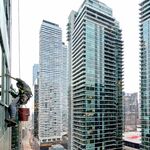ShonTron
Moderator
Member Bio
- Joined
- Apr 24, 2007
- Messages
- 12,540
- Reaction score
- 9,538
- Location
- Ward 13 - Toronto Centre
It's a 4km long loop, making it only 2km end-to-end. Seriously.
Someone pointed out that if you do the math for the Atlanta case, if you get to the streetcar stop and the streetcar isn't there, you're always better off simply walking rather than waiting.
That was exactly my experience. The Atlanta Streetcar might get a few more white people and tourists on transit, but that's about it.




